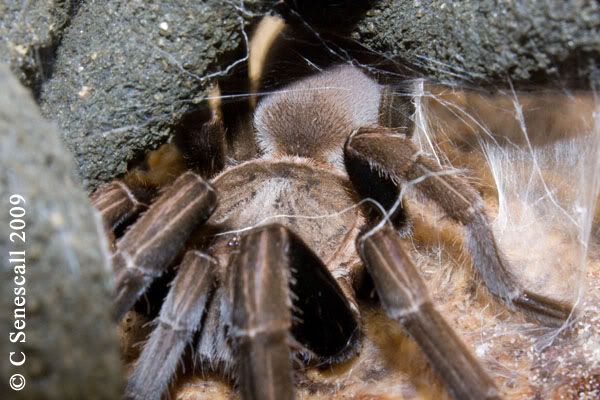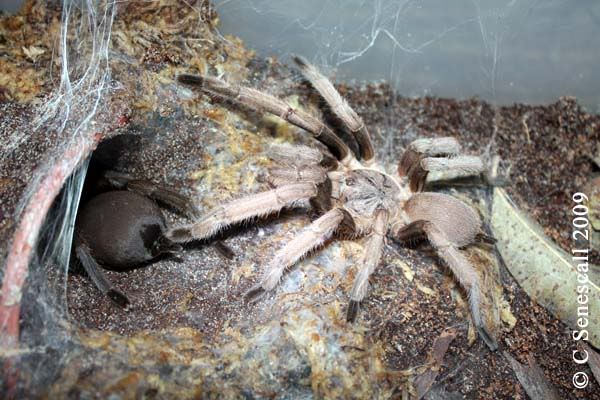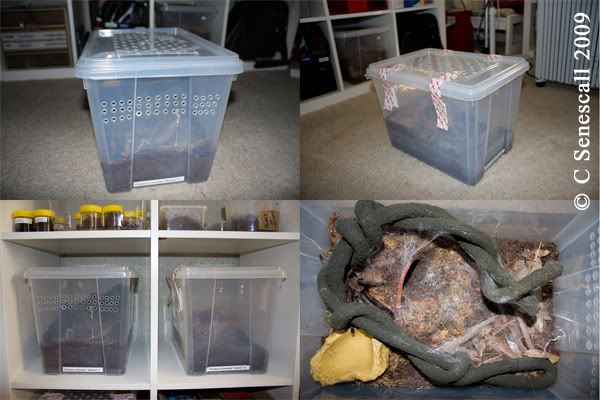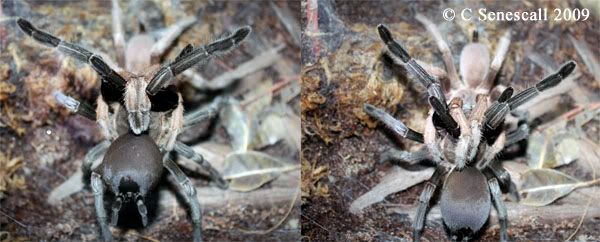
A mature female Phlogius crassipes "Eunice"
Another of the outstanding Australian tarantulas I am breeding this season is Phlogius crassipes "Eunice". Eunice is possibly a form of Phlogius crassipes, the type species for the genus and I am treating it as such as this seems to be the preferred classification at the moment and is in accordance with the preferred treatment at this time (pers com Steve Nunn). You will sometimes see it referred to as a seperate species Phlogius sp. "Eunice". This muddle should be sorted out when Dr Raven revises the genus and we are all hoping that revision will be published soon. Note that officially all of these species are still Selenocosmia at the moment however Raven has reserved Phlogius for them in his upcoming revision.

A mature male Phlogius crassipes "Eunice" showing sexual dimorphism compared to the female
In any case, semantics aside and ignoring the debate as to whether Eunice is a variety of Phlogius crassipes or a seperate species altogether, we can be sure that Eunice is closely related to Phlogius crassipes and a little more distantly related to Phlogius sp. "Sarina". Eunice is a more colourful form of the former and on mature female specimens a dark "zorro mask" can be seen around the eyes. The females are a dark chocolate brown colour overall. The sexually dimorphic males are much brighter, with dark femora. Males can have a larger leg span than the females but females are heavier. Eunice is, like it's sisters and cousins, one of the giant forms from the Southern Phlogius group from the mid north coastal region of Queensland and inhabits coastal rainforests and vine thickets. Eunice is not as dark as Sarina but it is darker than Phlogius crassipes seeming to fall midway between the two. The average diagonal legspan for a mature female is between 16 - 18cm.
Eunice is an opportunistic burrower and will appreciate bark slabs or an upturned half of a flower pot to build it's web and hide under. Immature specimens will burrow quite aggressively and plenty of substrate should be provided for them. Mature specimens will tend to show their opportunistic habits in captivity and should be provided with a hide or other cover under which they will web into a chamber. Mature specimens may not do much burrowing and can be kept on 6 cm of substrate. The container height should not be more than 1.5 times their length as a fall can injure or even kill them. Be wary of placing hard objects in the container on which they might fall. I have my breeding female in a 20 litre Starmaid tub with good ventilation proveded by holes in the lid and side made with the hot tip of a soldering iron. I have also included a large Exoterra fake vine in her enclosure and she seems to appreciate the additional cover this provides although it is not necessary. I use coco peat substrate mixed with 20% clean white beach sand which has been washed to remove excess salt. The sand is the fine white variety found on Queensland beaches. I also include moistened sphagnum moss on approximately 20% of the surface of the enclsure and around the hide entrance to assist with humidity as well as a water dish. Humidity for this species should be around 60-80% RH and as the species is tropical I keep the minimum temperatures to 22C. In it's native habitat winter temperatures range from 19-30C. I keep ambient humidity at the higher end of the scale in the warmer months and let it drop a little (but no less than 60%) from May to June. By webbing its hide or retreating into its opportunistic burrow the tarantula can seek out higher humidity should it feel the need. Be careful not to keep the Australian species on dry substrate as they will have trouble moulting and will not thrive. In summer temperatures here in Brisbane will rise naturally to 30C plus so only minimal heating is required in my spider room from May to July. After that I disconnect heating and let nature do the rest. My spiderlings and immatures are raised in the standard way in vials or large round deli containers with stable high humidity of 70%plus RH. I have managed to source a crystal clear variety of the later which are tall thus enabling plenty of substrate for the spiderling to burrow into. As they reach semi maturity they are potted up into successively larger containers until they are adults when they are rehoused into 20 litre or larger plastic tubs or even larger glass enclosures. For non-display purposes I prefer the plastic tubs which are light and easy to store in my spider room on the shelving I have arranged. Nothing however beats glass for a display tank for a large tarantula except perhaps clear perspex if you can get it! I find clear perspex very difficult to source here and so I do not use it a lot. That will change if I can find a relaible supplier.

Detail of enclosures used for mature specimens. Note the ventilation holes, velcro security fasteners, flower pot cut in half and partially buried for hide, Exoterra vine for additional cover, sphagnum moss on some of the substrate, water dish and leaves and bark strips.
Males will be ready for breeding from late March through to as late as November in the southern hemisphere and will be seen wandering in the wild in late May to early June. I assume in the USA and Europe the breeding period is reversed. This is a species, along with its sister species listed above that is available overseas so should be available for the dedicated enthusiast willing to track them down and research their requirements. In my matings some mild aggression has been displayed but the mating overall is a fairly calm process and you should have no trouble achieving it. Make sure the female is well fed before the breeding season and fatten the mature male up as well while he will eat to ensure he can produce sperm webs and to sustain him through the rigors of mating. After mating keep the female well fed without being silly about it to assist with formation of her eggs. These are big tarantuals and will eat a lot and I give them a variety of foods including crickets, roaches, locusts and also meal worms or superworms which I have found useful in putting condition on them. I also give them a defrosted pinkie mouse every 2 or 3 months. Feeding will slow as temperatures drop and may stop altogether in winter but by keeping minimum temperatures to around 22C adults will continue to feed. Slings and juvies will tend to feed longer at cooler temperatures but again I much prefer to keep their temperatures up a little to keep them active and growing. Slings and juvies should be kept well fed in order to reach their maximum potential and they are greedy eaters. By withholding food they will mature at reduced sizes which is not ideal although they will still be healthy and capable of breeding. I have had a male mature less than half the size of a standard well fed male which appeared to be due to halt in the feeding schedule. The size of a a mature Eunice is quite spectacular and as Sarina has been recorded at 20cm and Phlogius crassipes (Kattabul variety) at 23cm I would not be suprised to see female Eunice maxing out around 20cm in captivity when well kept.

Mating clasp of Phlogius crassipes "Eunice". Note the unique clasp adopted due to lack of tibial mating spurs.






how long does it take for a female eunice tarantula to reach full size?
ReplyDeleteHow long does a female eunice tarantula live for? and are they poisonous?
ReplyDeleteVenomous*, and yes they are...
ReplyDelete
ReplyDeleteHey mate I was hoping to have a chat to you tomorrow or Wednesday about getting a T from you,
I was wanting another large Sp to have in the entrance study to the home as a display tank and show peice.
I was hoping for a phlogius Crass or something similar that will grow very large over the years that i have her. Any ideas on what you may have at the moment and sale shipment price to perth please.
Scotty
0402449127